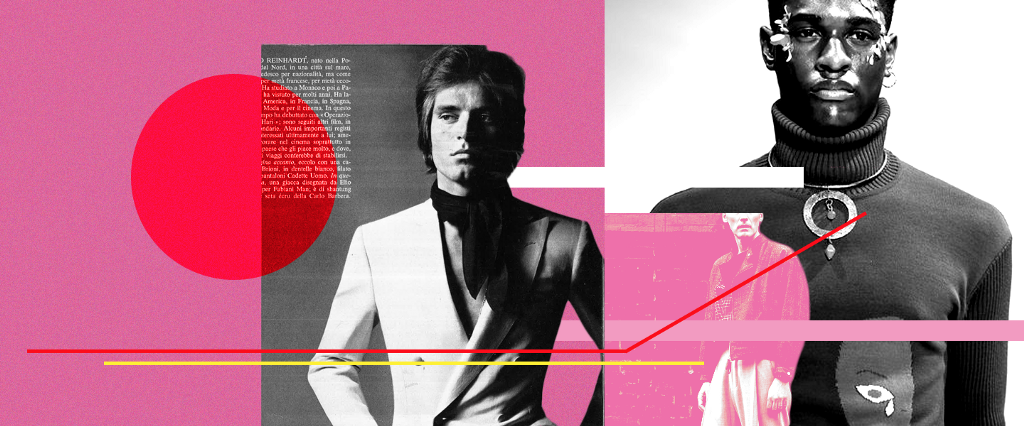When Jay McCauley Bowstead stumbled into an Army Navy store bathroom next to a train station in East London, he could see his teeth through a two-inch gash in his cheek. Moments earlier, a group of men shouting homophobic slurs stabbed the 18-year-old in the face because he was wearing lilac gloves, tight shredded jeans and a purple angora sweater. While it wasn’t the first time Bowstead had been physically assaulted for the way he dressed, it was definitely the bloodiest. Luckily, a plastic surgeon left only the faintest of scars, which Bowstead says serves as a reminder that you don’t need to subvert menswear all that much before people start to take offense.
This story also introduces Bowstead’s soon-to-be published book, Menswear Revolution: The Transformation of Contemporary Men’s Fashion. In it, he explores the myriad eras that have brought us to our current look: adventurous and challenging conservative notions of masculinity. That trajectory starts with the mod and peacock revolutions of the 1960s and runs through the new-wave aesthetics of the 1980s; oversized conservatism of the 1990s (think Chandler Bing); and rise of the “metrosexual” of the early aughts, during which men were given permission to moisturize, style their hair and make discerning fashion choices. From there, skinny jeans and the meterosexual hybridized into the hipster — short-shorts, singlets, ironic trucker hats — and, of course, hipster hate.
All of which brings us back to the present, which Bowstead, who also teaches cultural and historical studies at the London College of Fashion, refers to as “the queering of men’s fashion.” In fact, for him at least, the ubiquity of gender neutrality has become refreshingly conventional. Long gone are clear-cut differences of who should wear pink or blue, as people simply put on whatever feels comfortable.
If we’ve reached peak genderless fashion, though, where do we go from here? To find out, I ask Bowstead to look into his sartorial crystal ball.
Rise of the Dandy Grandpa
Unlike in other economic downturns, the menswear market has continued to grow and diversify after the 2008 financial crisis. Bowstead doesn’t think we’re in for a reversal in fortunes either. If anything, he predicts expansion. “There are still demographics poorly served by fashion,” he explains. “Older men, for example, who aren’t effectively marketed to by fashion brands because of a false belief that older men must automatically wish to dress in conservative and understated clothes. This, however, has been challenged by recent qualitative research.”
Death of the Work Suit
Thanks to growth of the tech industry and the gig economy, the conventional suit is dead. Or better put, men will only buy suits when they want to — and only wear them the way they see fit. For example, if you’re going to a wedding, Bowstead says, perhaps you’ll buy a suit that’s pink or off-white. “Or maybe it’s not that extreme,” he clarifies. “It might be that you buy an understated gray suit, but you wear it with purple Converse. Either way, it’s not how you’ll wear that suit to work.” Which, of course, you’ll likely never wear to the office anyway.
Athleisure Is Going Nowhere
Athletic clothes will continue to be a high-fashion choice, Bowstead predicts, with garments increasingly boasting zippers, tape and/or synthetic nylon. Adidas, ASOS and Nike now offer apparel meant for all occasions (i.e., not just the gym) — like leggings worn under shorts and oversized, longline tunics designed by Raf Simons and hyped by Hypebeasts. “Creative, expressive and unusual menswear won’t be confined to the catwalk,” he says. “It’s already a very visible phenomenon amongst cheaper retailers like Topman.”
Internationalwear
Already, garments that are typically foreign to Western traditions of cutting — e.g., tunics and kimono robes — are making their way to the U.S. and Europe. “We’ll be seeing more designers like Juun J from South Korea and Sean Suen from China,” he predicts, “with more of an Eastern silhouette approach. African menswear is also going to continue to take off, like Nigerian Lagos Street Style and collections inspired by South African Pantsula dancers.”
You’re Gonna Smell Genderless, Too
While he thinks gender will remain an important form of identity for most people, Bowsted also predicts that masculinity will continue to be redefined in a more expansive way, including styles less defined by traditional notions of masculinity. “When it comes to perfume, shampoo, soap and even makeup, the gendered way in which these products are divided up in stores seems increasingly anachronistic,” says Bowstead. “So I think this trend could continue. Nor does it necessarily have to be about very extreme forms of androgyny.”
Clothes 2.0
Body-scanners and digital pattern cutting could allow garments to be made to individual specifications at a lower cost, Bowstead explains, allowing consumers to have more input in the design process and become so-called “prosumers.”
In other words, a bespoke suit in the future will most likely be genderless athleisure from South Korea you design for yourself.

